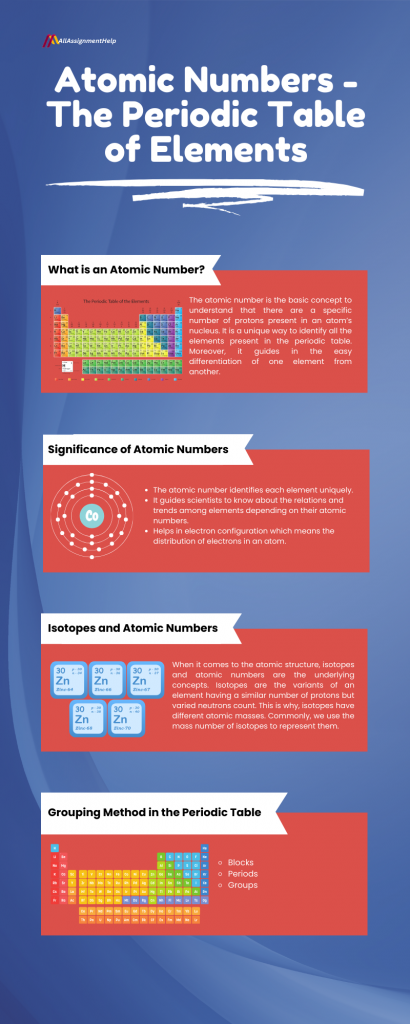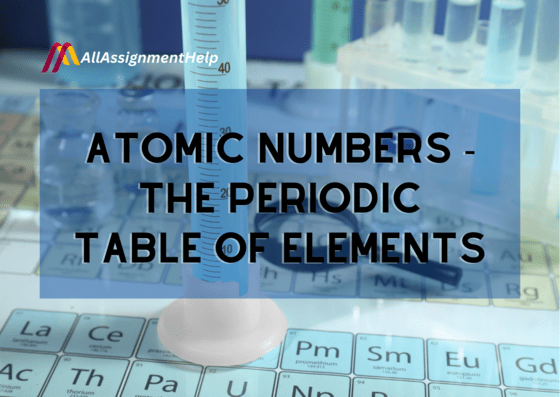Table of Contents
Through the Periodic Table of Elements, we get to learn how the structuring and organization of matter that builds components is done. In this classic chart, significant information is abundant. However, atomic numbers are striking as they help in understanding the attributes and behavior of each element in the table. In this blog by All Assignment Help, we will learn about the significance of atomic numbers alongside how they guide us in understanding the periodic table.
Introduction to Atomic Numbers
The atomic number is the basic concept to understand that there are a specific number of protons present in an atom’s nucleus. It is a unique way to identify all the elements present in the periodic table. Moreover, it guides in the easy differentiation of one element from another. Neutral atoms are generally electrically balanced as the atomic number and the number of electrons in the nucleus are equal. Dmitri Mendeleev is the father of the periodic table. Furthermore, initially, he categorized elements depending on their atomic masses. However, it was realized that the element’s properties correlated better with their atomic numbers. Hence, it resulted in the modern positioning of elements based on the ascending order of the atomic number.
In addition to this, if you want to understand the behaviour and characteristics of an element in chemical reactions, you must understand atomic number as it plays a significant role. Elements that have the same atomic number have similar chemical properties, they are identical and are from the same element. With a rise in the atomic number across the periodic table, elements get heavier and their chemical characteristics tend to vary. Therefore, we can say that the atomic number is a key parameter that helps in classifying the elements systematically. Also, it provides the basis for the arrangement and knowledge about the plethora of elements that make up the universe. Also, do you know what kind of spectra were analyzed to determine atomic numbers? The X-ray spectra are used to measure an element’s atomic number.
Also read: Biology Assignment: A Full Package Guide
Significance of Atomic Numbers
In order to understand the behaviour and properties of elements in chemistry, we need atomic numbers. Given below are some significance of atomic numbers that cannot be neglected.
- As we read earlier, a periodic table atomic number is a unique identifier. The number of protons in an atom’s nucleus is the atomic number. Moreover, different elements have different numbers of protons. Hence, the atomic number identifies each element uniquely.
- Elements on the periodic table are organized based on the rise in atomic number. Moreover, it guides scientists to know about the relations and trends among elements depending on their atomic numbers.
- A periodic table atomic number also helps in electron configuration which means the distribution of electrons in an atom. Electron configuration is needed to understand the chemical properties and reactivity of elements.
- It helps in understanding the chemical properties of elements. Moreover, elements with similar atomic numbers have similar chemical properties. This is because of similar electron configuration and organization of electrons in the outer levels of energy.
- Atoms in the same element can have varied numbers of neutrons and we call these variants isotopes.
Fine points
- Atomic numbers are also crucial to understand nuclear stability. The protons to neutrons ratio in the nucleus of an atom tells how stable an atom is. However, atoms can undergo radioactive decay if there is an imbalance in the protons to neutrons ratio to achieve a stable configuration.
- Elements combine to form compounds. We can learn more about it with the knowledge of atomic numbers.
Understanding atomic numbers can be tricky for some students, and they might need extra academic guidance. For that matter, you can seek help from your peers, teachers, etc. Moreover, getting easy-to-understand notes from experts can also be a great help. You can find online platforms that may provide you with professional assistance from experts. You can notify them with requests like, can you take my online class and help me understand atomic numbers better? As a result, you will get easily understandable notes from them that will teach you about the key parameters that explain the interactions of atoms, structure, and behavior.
Also read: Excellent Science Research Paper Topics for You

Isotopes and Atomic Numbers
When it comes to the atomic structure, isotopes and atomic numbers are the underlying concepts. Moreover, it helps in learning about the behaviour of elements and their properties. As we studied earlier, isotopes are the variants of an element having a similar number of protons but varied neutrons count. This is why, isotopes have different atomic masses. Also, they have different physical properties. Commonly, we use the mass number of isotopes to represent them. Furthermore, the sum of neutrons and protons together is called mass number. One can use their knowledge of isotopes in fields like medicine, nuclear physics, archaeology, etc. This is because it helps scientists to find out the origin of substances, date artefacts, etc. Hence, we can say that isotopes and atomic numbers together help us learn about the intricacies of the atomic world. Also, we can apply the knowledge in various scientific fields.
In addition to this, if you are looking forward to creating a detailed periodic table with atomic mass of all elements then it can be a complex and extensive task for you. However, you can seek assistance from an online coursework service for the same. The experts in the field can guide you without much hassle and can provide you with a detailed section of the periodic table.
Atomic Numbers: Grouping Method in the Periodic Table
Blocks
The blocks in the periodic table are the different sections. The naming of each block is done on the basis of the letter contained in the outermost subshell in which an electron is present. The four blocks consist of the s- s-block consisting of alkali metals in Group 1 and alkaline earth metals in Group 2. The p-block containing the group numbers 13-18, inclusive of all the metalloids. Also, there is the d-block that contains the group numbers 3-12 and consists of the transition metals. The f-block contains the lanthanides and actinides but they do not have any group number.
In addition to this, if learning about atomic numbers takes up enough space and time from your schedule, then there are chances of missing classes in other academic disciplines, such as physics. However, to overcome academic hurdles like who would take my online physics class, you can hire an expert and delegate the responsibilities to them. Moreover, you can keep your focus steady on learning about atomic numbers.
Periods
The vertical rows existing within the periodic table are referred to as periods. Lanthanides and actinides within the f-block demonstrate enhanced resemblance within the same period as compared to within the same group. When we are moving from left to right within a period there are certain occurrences such as a decrease in the atomic size due to the presence of a nuclear force that is extremely strong. There is an increase in ionization energy and also in electronegativity. Furthermore, there is an increase in the electron affinity, except the noble gases. Moreover, seek online assignment help in case of any academic difficulty related to the grouping method in the periodic table.
Groups
The modern periodic table consists of 18 vertical columns that are referred to as Groups. The total number of electrons existing in the outermost shell of an atom which is known as the Valence Shell is identical for all the elements under the same group. The group on the extreme left consists of the alkali metals and the group on the extreme right-hand side consists of noble gases. Elements that are located within the same column demonstrate identical chemical properties and they demonstrate periodicity when there is an enhancement in their atomic number.
Elements contained within the same group demonstrate patterns in their atomic radius, electronegativity and ionization energy. The numbering of the groups has been done from left to right from 1 to 18. It is interesting to learn that the conventions in naming the groups varied between Europe and America. However, since the year 1988 when the IUPAC names were put into place, the usage of the old names was abandoned. The arrangement of the groups is done in such a manner that as one moves down a group the atomic radius is enhanced, there is a decrease in electronegativity, except for Group 11 and there is a decrease in ionization energy.
Conclusion
In conclusion, we can say that atomic numbers are the threads that tie the Periodic Table of Elements together. Moreover, with the help of atomic numbers, we can systematically and efficiently understand, identify, and categorize the properties of elements. Furthermore, with this numerical key, we get to know about the secrets of atomic structure. Also, it helps scientists to explore the plethora of chemistry. Humankind will continue to unveil newer elements and learn more about the subatomic world. Among all this, the significance of atomic numbers stays at the utmost and always serves as the foundational knowledge through which we understand the elements that come together as the universe.
Frequently Asked Questions
| Question: What are periodic table atomic numbers? Answer: The periodic table can be considered as one of the most essential scientific documents which are developed in the form of a single table. It contains every kind of information related to chemical knowledge that human beings have imbibed since centuries. There are in total of 118 elements in the table that are arranged in terms of their atomic numbers and also according to the number of free electrons that are grouped according to the resemblances in their chemical properties. |
| Question: What are atomic numbers? Answer: The atomic numbers are the fundamental properties of an atom. The atomic number can be defined as the number of protons present in an atom. |
| Question: What is the history of periodic table? Answer: The first version of the periodic table was an attempt made by Antoine Lavoisier in the year 1789 where he published a list containing 33 chemical elements. These elements were grouped into categories of earth, metals, non-metals, and gases. |
